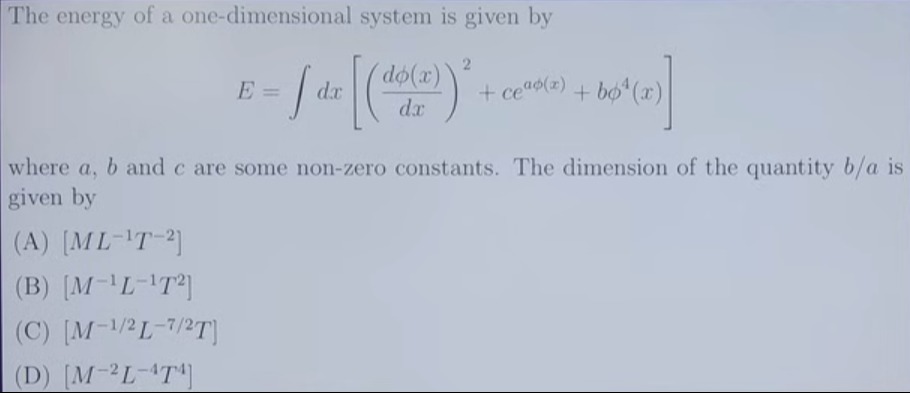Question
Question: The energy of a one-dimensional system is given by $E = \int dx \left[ \left( \frac{d\phi(x)}{dx} \r...
The energy of a one-dimensional system is given by E=∫dx[(dxdϕ(x))2+ceaϕ(x)+bϕ4(x)] where a, b and c are some non-zero constants. The dimension of the quantity b/a is given by

[ML−1T−2]
[M−1L−1T2]
[M−1/2L−7/2T]
[M−2L−4T4]
(C) [M−1/2L−7/2T]
Solution
The energy of a one-dimensional system is given by: E=∫dx[(dxdϕ(x))2+ceaϕ(x)+bϕ4(x)]
Let's determine the dimensions of each part of the equation. The dimension of energy [E] is [ML2T−2]. The dimension of dx is [L].
For the integral ∫dx[…] to have the dimension of energy, the term inside the square bracket must have the dimension of energy per unit length. So, [(dxdϕ(x))2+ceaϕ(x)+bϕ4(x)]=[L][E]=[L][ML2T−2]=[MLT−2].
According to the principle of dimensional homogeneity, each term inside the square bracket must have the same dimension, which is [MLT−2].
Let [ϕ] represent the dimension of ϕ(x).
-
Dimension of the first term: [(dxdϕ(x))2]=[MLT−2]
We know that [dxdϕ(x)]=[L][ϕ].
So, ([L][ϕ])2=[MLT−2]
[L2][ϕ]2=[MLT−2]
[ϕ]2=[MLT−2][L2]=[ML3T−2]
[ϕ]=[M1/2L3/2T−1]
-
Dimension of the second term: [ceaϕ(x)]=[MLT−2]
For an exponential function eX, the exponent X must be dimensionless. Therefore, [aϕ(x)]=[1] (dimensionless).
[a][ϕ]=[1]
[a]=[ϕ][1]=[M1/2L3/2T−1][1]=[M−1/2L−3/2T]
Since eaϕ(x) is dimensionless, the dimension of c must be [MLT−2].
-
Dimension of the third term: [bϕ4(x)]=[MLT−2]
[b][ϕ]4=[MLT−2]
[b]=[ϕ]4[MLT−2]
Substitute the dimension of [ϕ]:
[b]=([M1/2L3/2T−1])4[MLT−2]
[b]=[M(1/2)×4L(3/2)×4T−1×4][MLT−2]
[b]=[M2L6T−4][MLT−2]
[b]=[M1−2L1−6T−2−(−4)]
[b]=[M−1L−5T2]
Now, we need to find the dimension of the quantity b/a:
[ab]=[a][b]
[ab]=[M−1/2L−3/2T][M−1L−5T2]
[ab]=[M−1−(−1/2)L−5−(−3/2)T2−1]
[ab]=[M−1+1/2L−5+3/2T1]
[ab]=[M−1/2L−10/2+3/2T]
[ab]=[M−1/2L−7/2T]
Comparing this result with the given options, the calculated dimension matches option (C).
